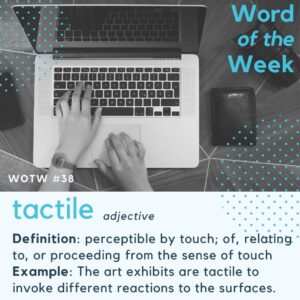The adjective tactile has to do with touch or sense of touch.

Other the definitions mentioned in the image above, it can also mean that something can be touched or tangible.
Quoting from the Merriam-Webster online dictionary:
Tangible is related to tactile, and so are intact, tact, contingent, tangent, and even entire. There’s also the uncommon noun taction, meaning “the act of touching.” Like tactile, all of these words can be traced back to the Latin verb tangere, meaning “to touch.” Tactile was adopted by English speakers in the early 17th century (possibly by way of the French tactile) from the Latin adjective tactilis (“tangible”). Tactilis comes from tactus, a past participle of tangere.
Other words that are derived from tactile are:
- tactilely (adverb)
- tactility (noun)
- tactilist (noun)
Depending on which side of the Atlantic, its pronunciation is different. In BrE*, it’s ˈtæktaɪl (sounds like tech-tile) while in AmE*, it’s normally pronounced as ˈtæktəl (sounds like tech-til).
Example sentences:
- Owning a pet is good for both elderly people and children who benefit from the tactile experience when they care for the pet.
- Not only is flannel a warm fabric, but it has a tactile surface that makes it so comfortable to wear.
- In some cultures, people are more tactile and tend to touch each other when they talk.
- All elevators should have tactile control buttons to help their visually-impaired.
- My cat has very specific tactile preferences; it will sleep on my blanket but not on the leather couch.
- As teachers, we cater for the child’s different learning preferences: kinesthetic, auditory, tactile, and visual learning.
- The new tactile learning kits allow the children to touch and explore different surfaces and shapes.
*BrE stands for British English.
*AmE stands for American English.
#wotw #wordoftheday #englishvocabulary

